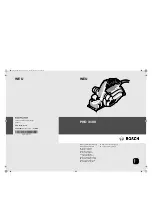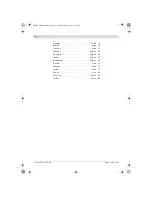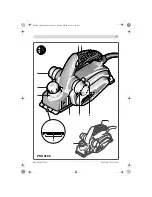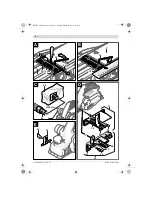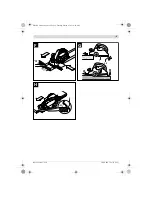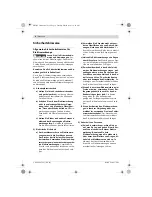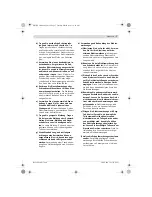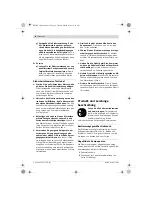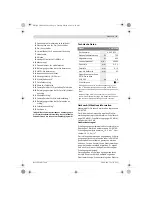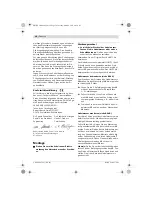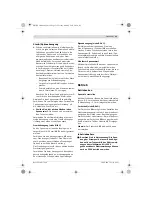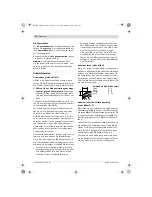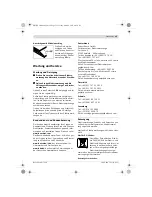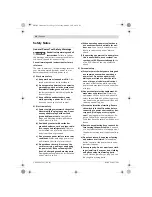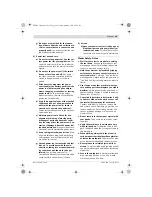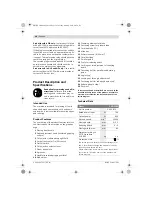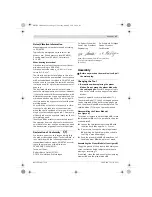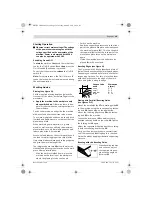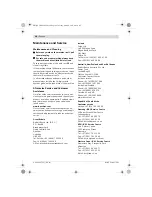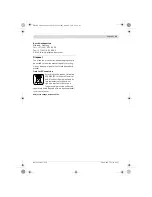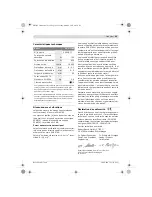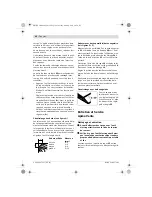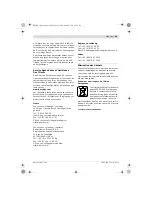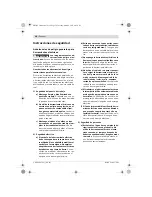
English |
15
Bosch Power Tools
2 609 140 721 | (8.3.11)
g) If devices are provided for the connec-
tion of dust extraction and collection fa-
cilities, ensure these are connected and
properly used.
Use of dust collection can
reduce dust-related hazards.
4) Power tool use and care
a) Do not force the power tool. Use the cor-
rect power tool for your application.
The
correct power tool will do the job better
and safer at the rate for which it was de-
signed.
b) Do not use the power tool if the switch
does not turn it on and off.
Any power
tool that cannot be controlled with the
switch is dangerous and must be re-
paired.
c) Disconnect the plug from the power
source and/or the battery pack from the
power tool before making any adjust-
ments, changing accessories, or storing
power tools.
Such preventive safety
measures reduce the risk of starting the
power tool accidentally.
d) Store idle power tools out of the reach of
children and do not allow persons unfa-
miliar with the power tool or these in-
structions to operate the power tool.
Power tools are dangerous in the hands of
untrained users.
e) Maintain power tools. Check for mis-
alignment or binding of moving parts,
breakage of parts and any other condi-
tion that may affect the power tool’s op-
eration. If damaged, have the power tool
repaired before use.
Many accidents are
caused by poorly maintained power tools.
f) Keep cutting tools sharp and clean.
Prop-
erly maintained cutting tools with sharp
cutting edges are less likely to bind and
are easier to control.
g) Use the power tool, accessories and tool
bits etc. in accordance with these in-
structions, taking into account the work-
ing conditions and the work to be per-
formed.
Use of the power tool for
operations different from those intended
could result in a hazardous situation.
5) Service
a) Have your power tool serviced by a qual-
ified repair person using only identical
replacement parts.
This will ensure that
the safety of the power tool is maintained.
Planer Safety Rules
f
Wait for the cutter to stop before setting
the tool down.
An exposed rotating cutter
may engage the surface leading to possible
loss of control and serious injury.
f
Hold the power tool by insulated gripping
surfaces only, because the cutter may con-
tact its own cord.
Cutting a “live” wire may
make exposed metal parts of the power tool
“live” and could give the operator an electric
shock.
f
Use clamps or another practical way to se-
cure and support the workpiece to a stable
platform.
Holding the work by your hand or
against the body leaves it unstable and may
lead to loss of control.
f
Use suitable detectors to determine if utili-
ty lines are hidden in the work area or call
the local utility company for assistance.
Contact with electric lines can lead to fire
and electric shock. Damaging a gas line can
lead to explosion. Penetrating a water line
causes property damage or may cause an
electric shock.
f
Do not reach into the saw dust ejector with
your hands.
They could be injured by rotat-
ing parts.
f
Apply the machine to the workpiece only
when switched on.
Otherwise there is dan-
ger of kickback when the cutting tool jams in
the workpiece.
f
When working, always hold the planer in
such a manner that the planer base plate fac-
es flat on the workpiece.
Otherwise the plan-
er can become wedged and lead to injuries.
f
Never plane over metal objects, nails or
screws.
The planer blade and the blade shaft
can become damaged and lead to increased
vibrations.
f
Secure the workpiece.
A workpiece clamped
with clamping devices or in a vice is held
more secure than by hand.
OBJ_BUCH-406-003.book Page 15 Tuesday, March 8, 2011 8:05 AM

